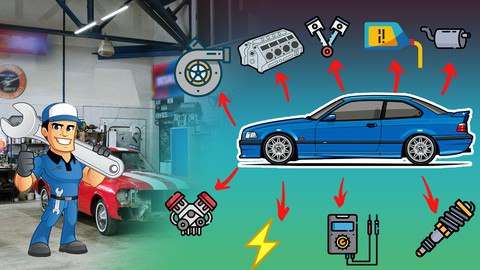
Learn the Car Repair from Beginner to Professional Level ! Also, get tips and tricks from the experienced mechanics.
What you will learn
Car Repair
Car Chassis Types
Car Suspension Types
Understanding Car Principles
Description
You are probably taking this course for one of two reasons. Either you are preparing yourself to enter into the field of automotive service, or you are expanding your skills to include automotive electrical systems. In either case, congratulations on selecting one of the most fast-paced segments of the automotive industry. Working with the electrical systems can be
challenging, yet very rewarding; however, it can also be very frustrating at times. For many people, learning electrical systems can be a struggle. It is my hope that I am able to present the course to you in such a manner that you will not only understand electrical systems, but will excel at it. There are many ways the theory of electricity can be explained, and many metaphors can be used. Some compare electricity to a water flow, while others explain it in a purely scientific fashion. Everyone learns differently. I am presenting electrical theory in a manner that I hope will be clear and concise. If you do not fully comprehend a concept, then it is important to discuss it with your instructor. Electricity is somewhat abstract; so if you do have questions, be sure to ask me in Udemy ask section.
Why Become an Electrical System Technician?
In the past, it was possible for technicians to work their entire careers and be able to almost completely avoid the vehicle’s electrical systems. They would specialize in engines, steering/ suspension, or brakes. Today, there is not a system on the vehicle that is immune to the role of electrical circuits. Engine controls, electronic suspension systems, and anti-lock brakes are common on today’s vehicles. Even electrical systems that were once thought of as being simple have evolved to computer controls. Headlights are now pulse-width modulated using high side drivers and will automatically brighten and dim based on the light intensity of oncoming traffic. Today’s vehicles are equipped with twenty or more computers, laser-guided cruise control, sonar park assist, infrared climate control, fiber optics, and radio frequency transponders and decoders. Simple systems have become more computers reliant. For example, the horn circuit on the 2008 Chrysler 300C involves three separate control modules to function. Even the tires have computers involved, with the addition of tire pressure monitoring systems!
Today’s technician must possess a full and complete electrical background to be able to succeed. The future will provide great opportunities for those technicians who have prepared themselves properly.
On the off chance that you’re not especially precisely slanted, you might watch the people who are with appreciation, surprise, and irritation since they have something you don’t: a comprehension of how things work and how things fit together. Whenever they dismantle something, they can reassemble it how it was. Whenever they say that they need to investigate the hood, they can really get the darn thing open. Furthermore, when they need to change a level, they don’t endure ten minutes attempting to sort out which end of the raise is.
Fortunately, you don’t need to be brought into the world with a wrench in your grasp to know how to fix things — even things as apparently convoluted as a vehicle. I know; I’ve been there. The Introduction fills you in regarding my car revelation.
Obviously, the easiest errands can once in a while be the greatest obstacles to survive. All things considered, in the event that you couldn’t actually sort out some way to open the hood, how might you check the oil or the coolant level? That is the reason I start this course with the essentials: straightforward positions that you’ll have to do over and over — like opening the hood, lifting a vehicle, and replacing a tire. I likewise incorporate guidelines for filling the gas tank yourself (it’s less expensive than full-administration), a reliable technique for dismantling anything and assembling it back once more, and security pointers that each technician — experienced and amateur — ought to notice.
Content